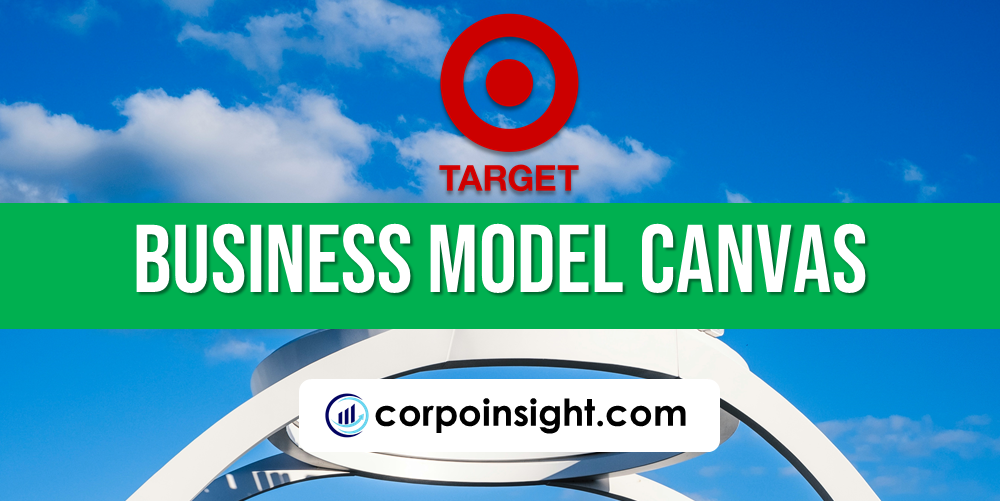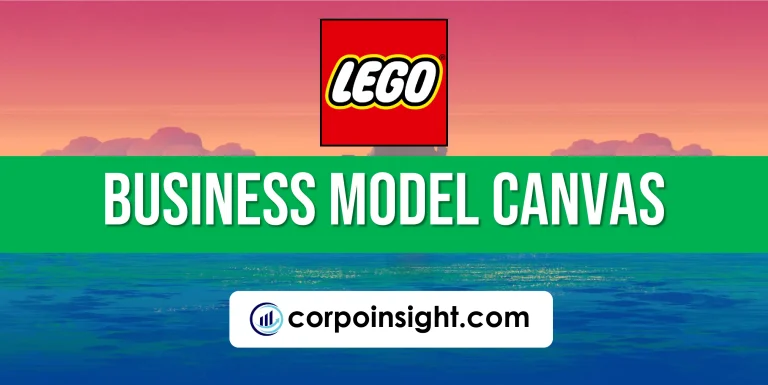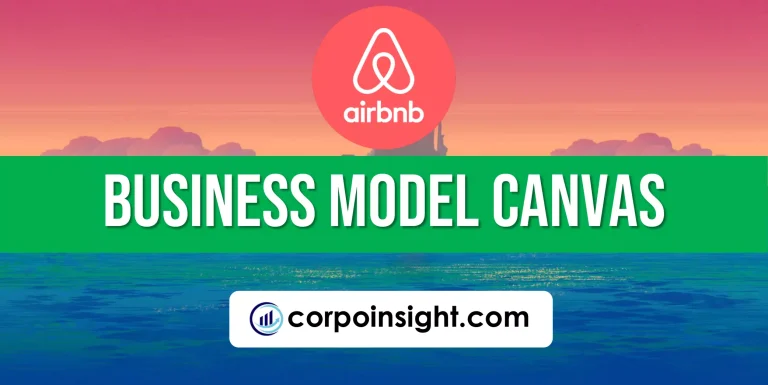Target Business Model Canvas 2024
Target, the beloved American big-box retailer providing affordable fashion, homewares, and essentials to millions of shoppers each day in its nearly 2,000 stores across the country and through its user-friendly website and app, has something for everyone. In this Target business model canvas, we will learn its customer segments, value proposition, revenue streams, channels, customer relationships, key activities, key resources, key partners, and cost structure.
Interesting fact!
The Target dog mascot was born when an executive brought his dog, Bullseye, to the office in 1999.
Target Competitors
Walmart | Amazon | Costco | Kroger | Home Depot | Lowe’s | Best Buy | Dollar General | Walgreens | Sears
Customer Segments – Target Business Model Canvas

Young Families: A major segment for Target is young middle-class families with children, comprising about a third of sales. For example, Target partnered with Disney in 2019 on an immersive, in-store children’s shopping experience that drove strong toy and clothing sales from millennial parents.
Affluent Suburban Women: Approximately 36% of Target’s sales come from an aspirational, stylist and family-oriented female demographic. Target cleverly aligned itself with high-end designers for elevated yet affordable style, such as its 2019 collaboration with Vineyard Vines, which sold out immediately.
Gen Z & Millennials: Younger demographics drive a lot of Target’s apparel and dorm/apartment home goods revenue. Its popular, limited-run collaborations with designers like Lilly Pulitzer and Hunter drive excitement and traffic from style-focused students. The trendy offerings lead to nearly $11 billion in annual apparel sales.
Urban Shoppers: Target is successfully penetrating urban markets, which were historically challenging. For instance, Target opened smaller-format stores in dense areas of Los Angeles in recent years, leading to double-digit comps growth from a new customer base. Approximately 36 urban stores now use the small-format strategy tailored to city shoppers.
Value Proposition – Target Business Model Canvas

Affordable Style: Target provides customers with accessible pricing on trendy, quality clothing and home furnishings, driving over $11 billion in annual apparel sales. For example, its 2021 designer dress collection with Lego drove significant traffic and sales by offering high-end collaborations at discounted prices.
One-Stop Shopping Convenience: With everything from groceries to home goods and tech accessories, Target meets customers’ variety of needs in one place, saving them time. This is evidenced by Target’s increase in food and beverage offerings to $15 billion in sales last year.
Omnichannel Experience: Target provides customers with a seamless experience across its nearly 2,000 stores and digital properties. In Q4 2021, for instance, 95% of Target’s sales were fulfilled by its stores, leveraging locations as small distribution hubs to meet e-commerce demand through innovations like Drive Up for ultimate convenience.
Strong Brand Ethos: Target maintains a brand spotlighting inclusivity, sustainability, and community giving. For example, Target committed $2 billion to support black-owned businesses by 2025, strengthening its brand affinity. This focus on corporate responsibility connects meaningfully with today’s purpose-driven shoppers.
Revenue Streams – Target Business Model Canvas
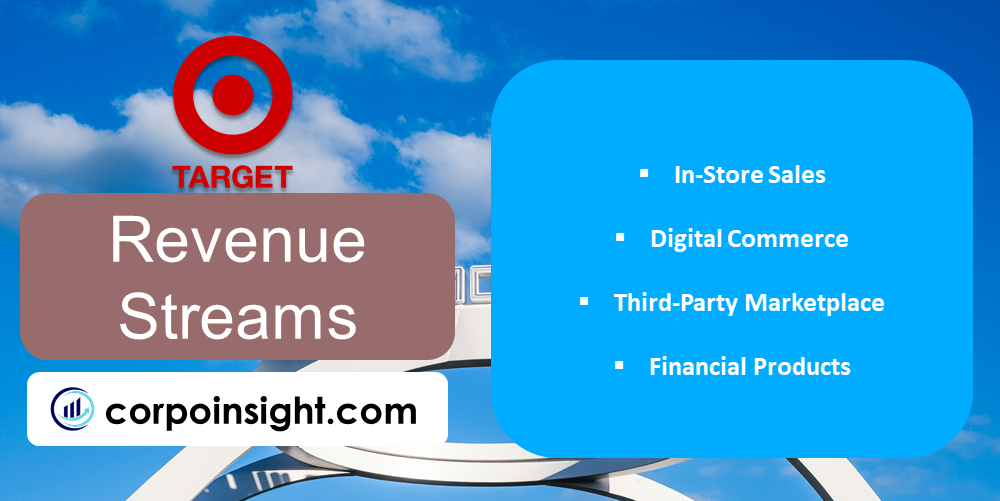
In-Store Sales: The majority of Target’s $106 billion in total 2021 revenue comes from in-person sales across departments in its 1,900+ stores. For example, store foot traffic drove strong Q421 apparel growth, leveraging exciting merchandising and remodelled fitting rooms.
Digital Commerce: Target’s e-commerce platform now accounts for over $15 billion in annual online sales. Services like same-day Delivery and Drive-up grew by nearly 90% last year as customers responded well to omnichannel convenience offerings.
Third-Party Marketplace: Target recently launched a third-party marketplace on its website, leveraging its traffic to expand its assortment. It now features over a quarter million marketplace products, providing new revenue streams from vendor commissions.
Financial Products: Target sells various financial products in-store, including Target credit cards and insurance offerings, which bring in substantial income. The company’s popular RedCard credit line, which offers 5% discounts, delivers lucrative ongoing financing business.
Channels – Target Business Model Canvas

Brick-and-Mortar Stores: Target reaches customers through its nearly 2,000 physical store locations across the U.S., which account for over 80% of total sales. For instance, remodelled stores and new small-format locations drove high foot traffic and record Q3 2021 store comps.
E-commerce Platform: Target’s redesigned website and app features online ordering with in-store and curbside pickup options for seamless omnichannel convenience. These enabled over $15 billion in FY2021 digital sales, as Target leverages stores to fulfil over 95% of online orders.
Social Media Presence: Target has over 18 million Instagram followers and engages customers through promotions on its Facebook and Twitter channels. For example, Target’s popular Instagram reels spotlight its limited-time “Deal of the Day” offerings.
Loyalty Programs: Target encourages repeat business through its free loyalty program, Target Circle, which has over 80 million enrolled members earning 1% rewards on purchases. This helps obtain valuable customer data for personalization while driving incremental sales.
Customer Relationships – Target Business Model Canvas
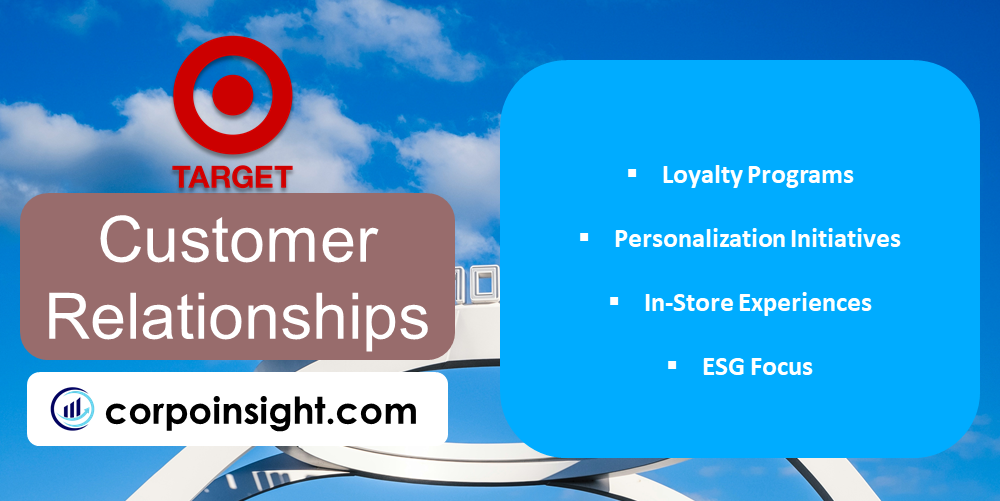
Loyalty Programs: Target’s free loyalty program, Target Circle, has over 80 million enrolled members who receive 1% rewards and personalized deals. This helps Target foster lasting connections, evidenced by RedCard penetration increasing to 27% in 2021.
Personalization Initiatives: Target leverages data-driven insights from its app and website to deliver customized content and offers to customers. For example, Target’s recommendation algorithm drives higher digital conversion based on individual preferences.
In-Store Experiences: Target invests heavily in experiential store retail, including the popular Target Café, immersive seasonal shops, and enhanced decor spaces, allowing customers opportunities to engage with the brand. In 2021, store traffic increased by over 15%.
ESG Focus: Target spotlights initiatives like sustainability, diversity, equity, and inclusion to align with customer values, recently committing $2 billion to support black-owned vendors. This corporate responsibility builds meaningful emotional connections with shoppers.
Key Activities – Target Business Model Canvas
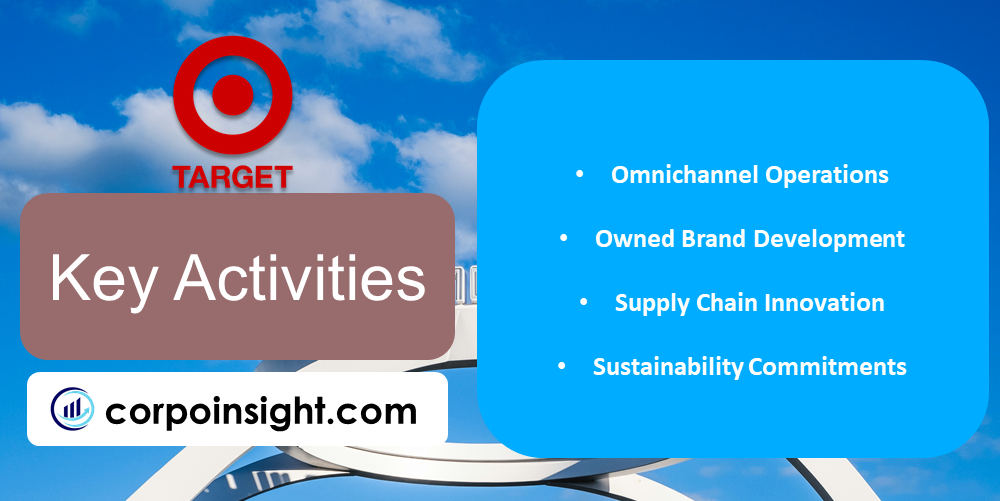
Omnichannel Operations: Target excels at leveraging its stores to fulfill over 95% of e-commerce orders while offering in-store pickup and curbside services. For example, Drive Up sales increased by over 90% in 2021, enabled by stores acting as localized distribution hubs. This seamless functionality drives growth.
Owned Brand Development: Target continuously refreshes popular owned brands like A New Day apparel, which hit $1 billion in 2020 sales. Frequent new product launches keep assortment exciting while exclusive offerings boost margins over national brands.
Supply Chain Innovation: Target is deploying various supply chain initiatives, including optimized forecasting through AI, expanding sortation centers to enable faster delivery, and improving inventory visibility. Such efforts allowed Target to ship over 650 million units from stores in 2021.
Sustainability Commitments: Target set ambitious sustainability goals around responsible sourcing, green transportation, and eco-friendly stores. For instance, it aims for 100% renewable electricity and net-zero emissions by 2030, appealing to eco-conscious shoppers.
Key Resources – Target Business Model Canvas
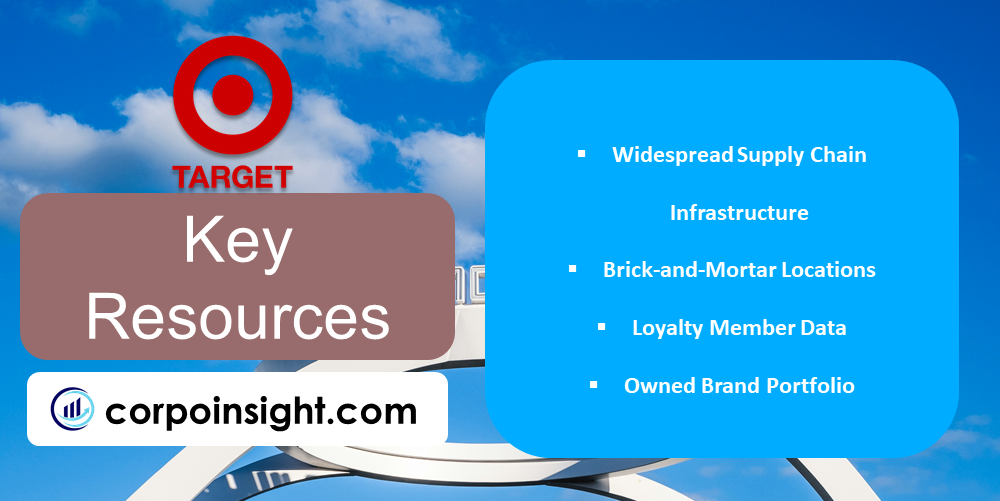
Widespread Supply Chain Infrastructure: Target operates over 40 nationwide distribution centers along with regional sortation facilities totaling over 100 million square feet to optimize delivery. This vast network allows Target to ship items to stores for next-day pickup and localize online order fulfillment.
Brick-and-Mortar Locations: Target’s nearly 2,000 physical stores located within 10 miles of approximately 90% of the US population provide immense reach. These convenient locations act as the foundation for its booming omnichannel ecosystem.
Loyalty Member Data: Target leverages rich cardholder and purchasing data from over 80 million Target Circle loyalty members to derive insights that personalize the shopping experience. This data also informs accurate demand forecasting to optimize inventory.
Owned Brand Portfolio: Target continually invests in building an exclusive portfolio of over 30 Owned Brands spanning $18 billion in yearly sales and accounting for roughly a third of total revenue. These differentiated brands boost margins and customer loyalty.
Key Partners – Target Business Model Canvas

Global Suppliers: Target works with a diverse base of over 30,000 global suppliers to ensure reliable access to quality, affordable products across a wide range of categories, such as Dollar Spot merchandising partners like Greenbrier International for everyday home essentials.
Third-Party Marketplace Sellers: By expanding its online marketplace to over 250,000 third-party seller products, Target supplements its assortment while sharing commissions with partners in high-demand categories like electronics, sporting goods, and toys.
Delivery Logistics Providers: To meet online delivery demands, Target partners with innovative parcel carriers through its network-wide Delivers program, including its new partnership with Uber to facilitate same-day delivery powered by Shipt’s platform and drivers.
Designer Label Partnerships: To extend its “Tarjay” high-end branding halo, Target frequently collaborates with luxury names such as Hunter for rainboots and Zac Hanson for eyewear. These limited-edition designer lines elevate fashion credibility and customer buzz.
Cost Structure – Target Business Model Canvas
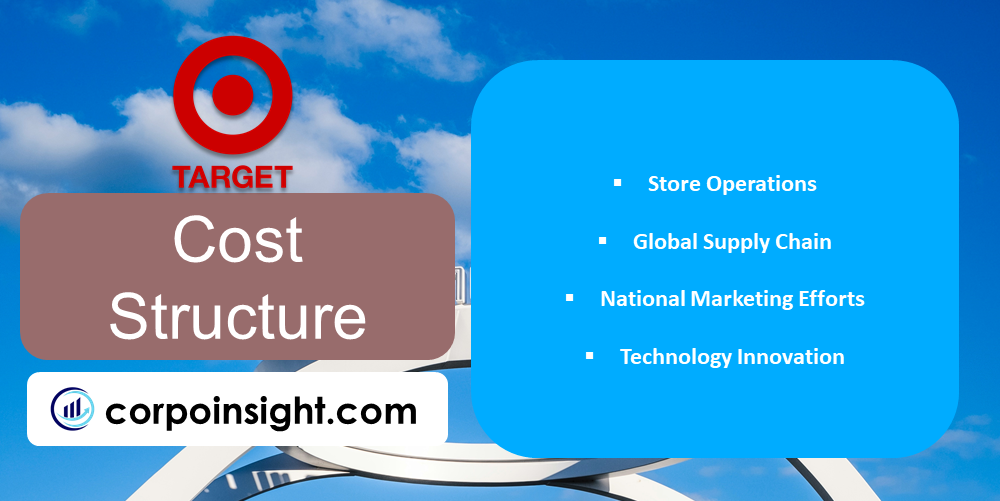
Store Operations: Target invests significantly in its nearly 2,000 stores, including employee payroll, new locations, remodels, and omnichannel distribution capabilities, enabling over 95% of digital orders to be fulfilled by stores. In 2021, it planned to remodel over 200 locations and open 30 new stores.
Global Supply Chain: Target operates over 40 distribution centers and expanding regional sortation centers to optimize inventory management. For example, opening more e-commerce sortation centers close to density clusters cuts last-mile delivery expenses. Total supply chain costs were $6.2 billion in 2021.
National Marketing Efforts: Target spends roughly $1.4 billion annually on advertising, using a multi-channel approach across TV, print, digital, and in-store promotions to drive brand awareness and sales growth for both its owned and national brands. Its recognizable marketing drives loyalty.
Technology Innovation: Target continually invests in improving its commerce technologies and data capacities, including apps, website enhancements, and machine learning-based inventory planning. Its technology costs totaled over $1.6 billion in 2021.
Summary of Target Business Model Canvas
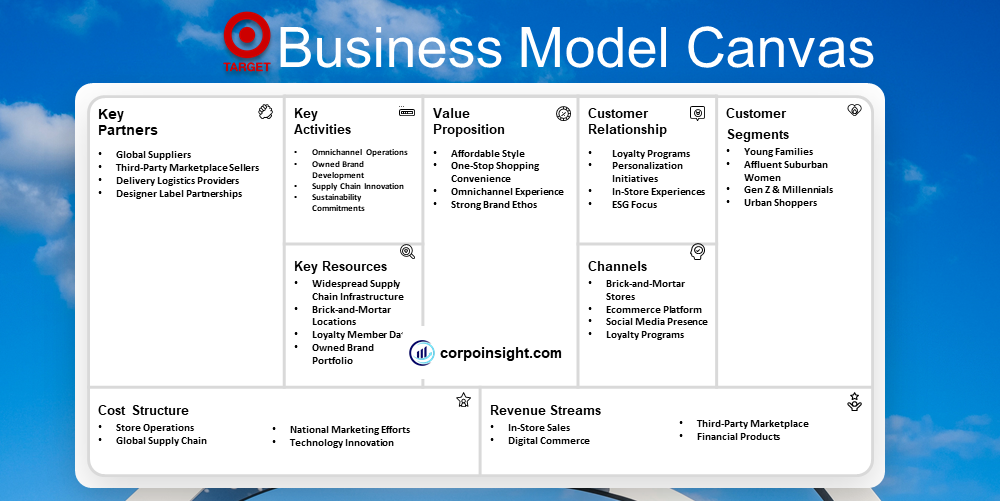
Conclusion on Target Business Model Canvas
Target has crafted an exceptionally strong retail business model canvas fueled by its vast omnichannel distribution capabilities, leveraging nearly 2,000 convenient, experiential stores. By continuing to innovate supply chain operations to profitably fulfill over 95% of e-commerce orders via these localized hubs while also deepening owned brand penetration and loyalty programs, Target drives profitable growth across high-value demographics, including young families, suburban parents, and style-focused millennials. If Target sustains technology and analytical advancements to elevate personalization and inventory planning, it will cement leadership in delivering outstanding value, assortment, and convenience to shoppers nationwide.

This is Ahsanul Haque, someone very passionate about digital marketing, SEO, and Data Analytics and founder of the Analytics Empire and currently pursuing my major in marketing at Bangladesh University of Professionals.

